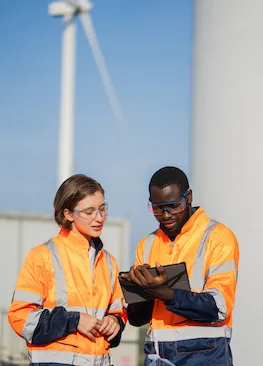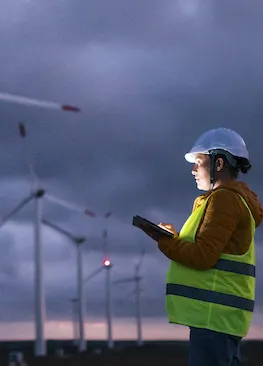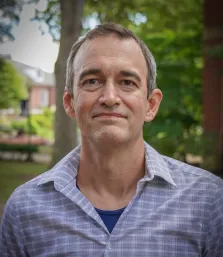Whether you desire to pursue a career in sustainability management, energy consulting, or perhaps serve as an executive leader within a corporation that embraces sustainability, our world needs people like you now.
Join a Virtual Information Session with Dr. Jeremy May to learn more about the program.
Register for a Virtual Information Session
Across the world sustainability is driving the future of how industries and governments operate. Organizations in all sectors are becoming increasingly concerned about and committed to protecting and sustaining our natural resources. Individuals who address critical sustainability challenges head-on through the development of innovative and practical solutions to environmental harm, the implementation of sustainable practices and policies, and the cultivation of leadership skills will be the necessary force for good.
Are YOU ready to build the expertise needed to help fill such critical roles?
The Master of Arts degree in Environmental Sustainability Leadership (MESL) program at Marietta College is a fully online multidisciplinary program that empowers students to master an understanding of the complex systems that intersect in sustainability leadership. Students will tackle sustainability challenges from different perspectives and work collaboratively to find solutions that address the triple bottom line of protecting people, the planet, and profits.
By working on real-world problems, students learn how to lead organizational efforts to build a more environmentally sustainable future for their organizations and stakeholders. The MASL program at Marietta College is designed to have a global focus, be flexible, and convenient for individuals who may have other life responsibilities like working and/or caring for loved ones.
The program consists of 10 eight-week courses (30 credits) and is designed for completion in two years. Students may complete the first nine courses in any order and then complete the program by taking the Capstone Project course in which students apply that knowledge to a real-world case study in their final capstone project. All courses are online and a combination of synchronous and asynchronous learning.
Requirements for a Master of Arts degree in Environmental Sustainability Leadership
The following courses are required for the Master of Sustainability Leadership program (currently under revision).
- MASL 501 Systems Thinking and Sustainability
- MASL 502 Environmental Science
- MASL 503 Data Analysis and Decision Making
- MASL 504 Environmental Economics
- MASL 505 Environmental Policy and Law
- MASL 506 Sustainable Resource Management
- MASL 507 Environmental Leadership and Ethics
- MALS 508 Communicating Environmental Science
- MALS 509 Corporate Sustainability Leadership
- MALS 510 Master’s Capstone Project
MESL 501-505 ensure a solid foundation in the main subject areas that are related to sustainability and application to aspects of government and industry. MESL 506-509 emphasize on sustainability leadership and focus on systemic thinking within the perspective of resource management, ethics, communication, and corporate leadership. All courses except the capstone can be taken in any order.
The capstone course provides an opportunity for students to synthesize the knowledge learned in each of the courses in the MESL program in the context of a real-world project or case study that relates to sustainability. The capstone project should identify a problem, provide a proposed solution to the problem, suggest a way to assess the efficacy of the proposed solution and examine the role that leadership would have in implementing the solution. In some situations, an exception may be granted that would allow a student to take the capstone course at the same time as they are taking their last course, or before they have taken the last course. Exceptions to the sequence of the capstone must be approved by the program director and/or provost.
Admission Requirements
Admission to the MASL program requires prior completion of a bachelor's degree from an accredited US institution of higher education or its foreign equivalent. Any field is acceptable as Sustainability Leadership is a multidisciplinary field of study. The ideal candidate would have an undergraduate degree with a cumulative grade point average (GPA) of 3.0 or higher and coursework in business and/or science. The GRE is not required.
Additional admission criteria include:
- Statement of purpose not to exceed 600 words, including interest in the field of substantiality leadership and how completion of the degree will support your long-term career goals.
- One letter of recommendation from people who can attest to the applicant's academic and professional achievements through firsthand knowledge.
- Work and/or significant volunteer experience is strongly recommended but not required.
Candidates with an undergraduate GPA below 3.0 should contact the program director to discuss their qualifications.
Application Procedure
To apply for admission to the MASL Program, the applicant must complete the program application found at https://apply.marietta.edu/register/mslapp, including uploading the following:
- A statement of purpose, including career goals and interest in the field of substantiality leadership;
- One letters of recommendation attesting to the candidate’s capacity to complete graduate-level work.
Official transcripts are required and should be submitted to:
The Office of Admission
Marietta College
215 Fifth Street
Marietta, Ohio 45750
1-800-331-7896
admit@marietta.edu
Electronic delivery is preferred. Please note that electronic transcripts forwarded by the applicant are not considered to be official but should be sent to Marietta College directly by the issuing institution. Likewise, printed transcripts must be received directly from the issuing institution or forwarded in a sealed envelope from the institution.




Unique Program Features
The Master of Sustainability Leadership program builds on strengths that have existed at Marietta College for decades and is part of the new Center for Earth, Energy, and Environment. Faculty from our long-established and highly respected Petroleum Engineering program and the McDonough Center for Leadership and Business collaborate and contribute to the delivery of our online curriculum which blends both asynchronous and synchronous course components in every class offering. Because this is a fully online program, it will not qualify a student for F-1 Visa status.
Career Opportunities
Graduates with education and experience in the field of sustainability will have access to an ever-increasing number of roles in both the public and private sectors, including business, government, and academia.
- Career opportunities for graduates of this program include:
- Chief sustainability officer
- Sustainability communications specialist
- Sustainability instructor or teacher
- Sustainability specialist
- Conservation program lead
- Environmental restoration planner
- Program director or manager
- Disaster relief consultant
- Energy consultant
- Zero waste consultant
Career Advising & Mentorship
Whatever your career goals, Marietta College is here to support you! The Marietta College Center for Entrepreneurship and Career Development (CECD) provides a wide variety of services to empower students to take ownership of their future. Feel free to contact the CECD at 740.376.4924 or cc@marietta.edu.
FAQs
- What is the Master of Environmental Sustainability Leadership program?
The Master of Sustainability Leadership is a program that empowers students to understand the complex systems that intersect in the field of sustainability leadership. This involves a multidisciplinary approach, looking at sustainability challenges from different perspectives as students work to find solutions that address the needs of people, and the planet, and making a profit. By working on real-world problems, students learn how to lead organizational efforts to build a more environmentally sustainable future for their organizations and their organization’s stakeholders.
- What can prospective students expect from this program?
Students participate in online and collaborate in discussions that are directed by prompts related to each week’s course materials. The students in the program all have unique backgrounds and those experiences bring diverse observations to the course. The instructor for the course is a subject matter expert who leads the discussion, but then students can share their experiences and thoughts that relate to the topics being discussed.
Another common characteristic of the courses is that they all bring in examples of real-world cases that are used as part of the discussion and are often incorporated into assignments. By the time a student completes the program, they will be able to readily identify sustainability problems, be able to work to propose possible ways of addressing the problems, be able to develop strategies for gaining buy-in from stakeholders in the organization and be able to put the solution into effect.
- What makes Marietta's online Master of Environmental Sustainability Leadership different than other colleges/universities?
There are two things that set Marietta College’s Master of Sustainability Leadership program apart from other similar programs. First, many programs are primarily asynchronous. This is easier, but we think the value of building a learning community is important. Therefore, we have a synchronous component in all courses so that students can learn from the diverse work experiences of the instructors and other students.
The Master of Sustainability Leadership also builds on strengths that have existed at Marietta College for decades. The McDonough Center for Leadership and Business was one of the first undergraduate leadership programs in the country and has remained one of the strongest undergraduate leadership programs. Marietta College also is home to a Petroleum Engineering and Energy Systems program that has been accredited since 1984 and was the first program at a liberal arts college to be accredited. In addition to Petroleum Engineering, this department also offers courses in Environmental Engineering and Energy Systems. Faculty from both of these programs will be involved in the Sustainability Leadership program. Finally, the Master of Sustainability Leadership is a part of the new Center for Earth, Energy, and Environment.
- Who should consider pursuing a Master of Environmental Sustainability Leadership degree?
This program is designed for people that have an interest in sustainability and helping to solve problems, and are looking for a way to advance their careers. Openings in sustainability are a growing area in the job market and include positions such as sustainability officers, ESG officers, environmental and sustainability consultants, and environmental compliance and sustainability project managers.
- What are the courses that are required for a Master of Environmental Sustainability Leadership degree?
The following courses are required for the Master of Sustainability Leadership program.
- MASL 501 Systems Thinking and Sustainability
- MASL 502 Environmental Science
- MASL 503 Data Analysis and Decision Making
- MASL 504 Environmental Economics
- MASL 505 Environmental Policy and Law
- MASL 506 Sustainable Resource Management
- MASL 507 Environmental Leadership and Ethics
- MALS 508 Communicating Environmental Science
- MALS 509 Corporate Sustainability Leadership
- MALS 510 Master’s Capstone Project
Students coming into the program would ideally have some coursework in the sciences and/or in business. The first five courses in this list help to make sure that all the students, regardless of their undergraduate background, have a solid foundation in the main subject areas that are related to sustainability. The last four courses place more of an emphasis on how leadership is related to sustainability and focus on leadership from the perspective of resource management, ethics, communication, and corporate leadership.
The first nine courses in this list can be taken in any order. Ideally, a student would take the first nine courses before taking the capstone course. However, we realize that sometimes it might be necessary for a student to take the capstone course at the same time as they are taking their last course, or before they have taken the last course.
The capstone course provides an opportunity for students to synthesize the knowledge learned in each of the courses in the MSL program in the context of a real-world project or case study that relates to sustainability. The capstone project should identify a problem, provide a proposed solution to the problem, suggest a way to assess the efficacy of the proposed solution and examine the role that leadership would have in implementing the solution.
- How long will it take to complete a Master of Environmental Sustainability Leadership degree?
The program consists of 10 courses, and these courses are designed to be taken while a student is also working. There will be five terms each year and by taking one course each term the program can be completed in two years. Each course has both synchronous and asynchronous components. The synchronous part of the course will be offered on a weekday evening as a Zoom meeting of the instructor with the students.

